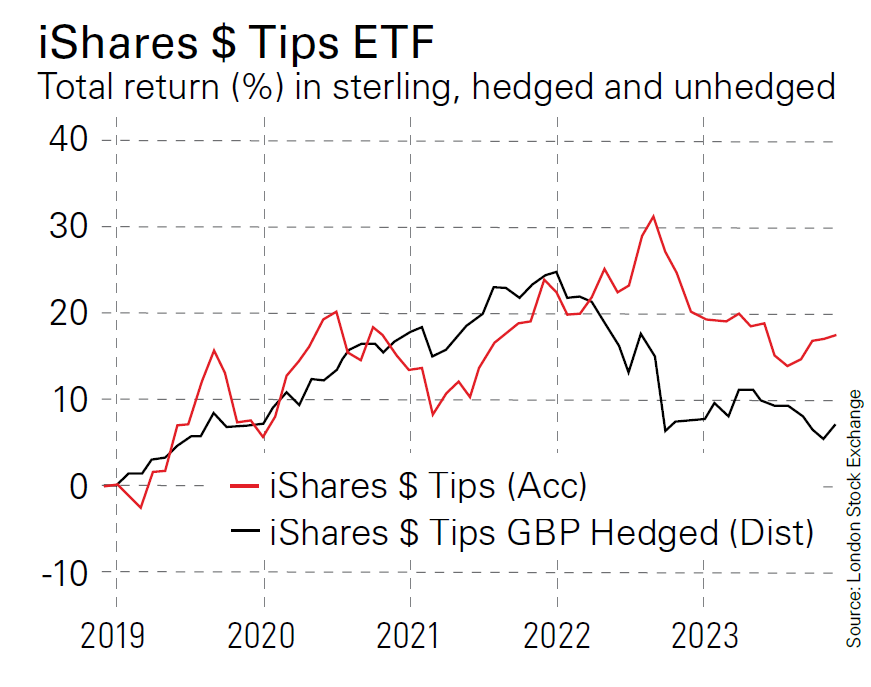Trust in US TIPS to beat inflation
In an inflationary market TIPS, US Treasury Inflation-Protected Securities, are most compelling says Cris Sholto Heaton.


Bond yields have ticked down recently as investors conclude that central banks have finished hiking. Whether this is right remains to be seen, but my long-standing view is that central banks are always too quick to cut and too slow to hike and so I’d guess that markets are probably correct.
However, this has little immediate impact on the MoneyWeek asset-allocation strategy that I’ve been reviewing in the last few weeks, since we try not to forecast too much: our goal is to have a portfolio fit for all likely outcomes. With that in mind, the 2%-2.5% real yield on inflation-linked bonds still looks better than conventional bonds.
Government-backed linkers are an unusually generous gift to investors since they promise to pay you back in a money that retains its value, rather than money that is debased by inflation. It is true, of course, that politicians could potentially fiddle the inflation statistics to some extent, but if they are doing that, actual inflation is likely to be so bad that conventional bonds will lose even more value.
MoneyWeek
Subscribe to MoneyWeek today and get your first six magazine issues absolutely FREE

Sign up to Money Morning
Don't miss the latest investment and personal finances news, market analysis, plus money-saving tips with our free twice-daily newsletter
Don't miss the latest investment and personal finances news, market analysis, plus money-saving tips with our free twice-daily newsletter
There are fewer choices for inflation-linked bond exchange-traded funds (ETFs) than conventional bond ETFs because this is a smaller market, but what’s available is still as much as we need. Most obviously for the UK investor, we have iShares £ Index-Linked Gilts (LSE: INXG). Given that most of us will have liabilities and costs in sterling and be at risk from UK inflation, in principle, it makes sense to have our investment indexed against that. However, as I discussed last time, the UK linker market is structurally messy and so I prefer US Treasury Inflation-Protected Securities (TIPS).
US TIPS Funds

iShares $ Tips ETF Total return (%) in sterling, hedged and unhedged
With TIPS we have a choice of broad funds such as iShares $ Tips (LSE: ITPS), Lyxor Core US Tips (LSE: TIPG) and SPDR Bloomberg US Tips (LSE: UTIP).
There are also a few funds that break the market down by maturity, as with the conventional bond ETFs – for example iShares $ Tips 0-5 (LSE: TP05) or UBS Bloomberg Tips 10+ (LSE: UBTL).
There are also some euro ETFs, such as iShares € Inflation-Linked Government Bond ETF (LSE: IBCI), which is mostly French and Italian bonds and global ETFs, such as iShares Global Inflation-Linked Government Bond ETF (LSE: SGIL), which is around 50% US bonds. But for our purposes, these add little.
First, US linkers have the highest real yields. Second, US bonds are a safe-haven asset – they tend to rally during crises, which is another attractive reason to hold some.
Several of these ETFs are available as currency-hedged funds, such as iShares $ Tips GBP Hedged (LSE: ITPG). Hedging conventional bonds can make sense – the yield you get from bonds can easily be swamped by currency losses if exchange rates move against you. However, in this situation, I see a good argument to hold US linkers unhedged. If UK inflation turns out to be much worse than US inflation, we would expect sterling to weaken against the dollar over time. ITPS has beaten ITPG over five years for this reason (see chart above).
Put all this together, and we will continue to hold 10% in ITPS.
This article was first published in MoneyWeek's magazine. Enjoy exclusive early access to news, opinion and analysis from our team of financial experts with a MoneyWeek subscription.
Related articles
- Index-linked bonds could prove a costly inflation hedge
- Are bonds bouncing back?
- What you need to know about investment funds
Get the latest financial news, insights and expert analysis from our award-winning MoneyWeek team, to help you understand what really matters when it comes to your finances.
Cris Sholto Heaton is an investment analyst and writer who has been contributing to MoneyWeek since 2006 and was managing editor of the magazine between 2016 and 2018. He is especially interested in international investing, believing many investors still focus too much on their home markets and that it pays to take advantage of all the opportunities the world offers. He often writes about Asian equities, international income and global asset allocation.
Cris began his career in financial services consultancy at PwC and Lane Clark & Peacock, before an abrupt change of direction into oil, gas and energy at Petroleum Economist and Platts and subsequently into investment research and writing. In addition to his articles for MoneyWeek, he also works with a number of asset managers, consultancies and financial information providers.
He holds the Chartered Financial Analyst designation and the Investment Management Certificate, as well as degrees in finance and mathematics. He has also studied acting, film-making and photography, and strongly suspects that an awareness of what makes a compelling story is just as important for understanding markets as any amount of qualifications.
-
 UK interest rates: will the MPC lower rates?
UK interest rates: will the MPC lower rates?The Bank of England’s Monetary Policy Committee’s (MPC) final interest rates meeting of the year takes place tomorrow (18 December) and most experts expect a cut
-
 A quarter of a million more pensioners in poverty after state pension age rises – will it go higher?
A quarter of a million more pensioners in poverty after state pension age rises – will it go higher?When the state pension age rose to 66, the percentage of 65-year-olds in income poverty more than doubled, new research suggests
-
 British blue chips offer investors reliable income and growth
British blue chips offer investors reliable income and growthOpinion Ben Russon, portfolio manager and co-head UK equities, ClearBridge Investments, highlights three British blue chips where he'd put his money
-
 Coreweave is on borrowed time
Coreweave is on borrowed timeAI infrastructure firm Coreweave is heading for trouble and is absurdly pricey, says Matthew Partridge
-
 Renewable energy funds are stuck between a ROC and a hard place
Renewable energy funds are stuck between a ROC and a hard placeRenewable energy funds were hit hard by the government’s subsidy changes, but they have only themselves to blame for their failure to build trust with investors
-
 Profit from document shredding with Restore
Profit from document shredding with RestoreRestore operates in a niche, but essential market. The business has exciting potential over the coming years, says Rupert Hargreaves
-
 The war dividend – how to invest in defence stocks as the world arms up
The war dividend – how to invest in defence stocks as the world arms upWestern governments are back on a war footing. Investors should be prepared, too, says Jamie Ward
-
 Literacy Capital: A trust where great returns fund a good cause
Literacy Capital: A trust where great returns fund a good causeThere’s plenty to like about specialist private-equity trust Literacy Capital, says Max King
-
 An AI bust could hit private credit – could it cause a financial crisis?
An AI bust could hit private credit – could it cause a financial crisis?Opinion Private credit is playing a key role in funding data centres. It may be the first to take the hit if the AI boom ends, says Cris Sholto Heaton
-
 8 of the best ski chalets for sale now
8 of the best ski chalets for sale nowThe best ski chalets on the market – from a traditional Alpine-style chalet in Switzerland to an award-winning Modernist building in Japan’s exclusive ski areas
